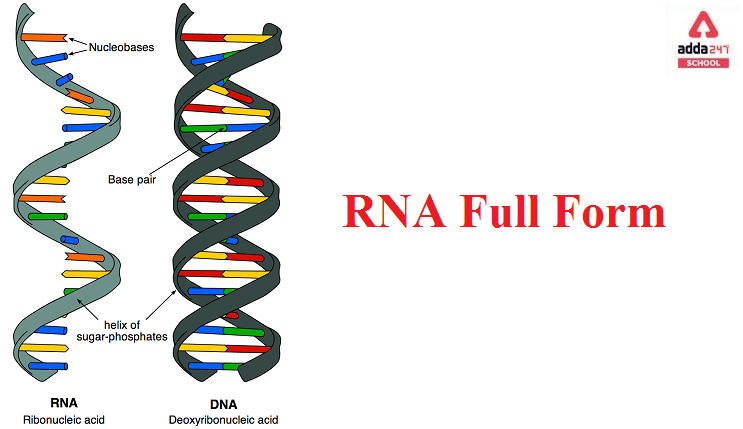Table of Contents
RNA Full Form
RNA Full Form – Ribonucleic Acid full details are available here. Ribonucleic acid is a polymeric molecule that plays a variety of roles in biology, including gene coding, decoding, regulation, and expression. Nucleic acids include RNA and DNA. Nucleic acids are one of the four primary macromolecules required for all known forms of life, alongside lipids, proteins, and carbohydrates. RNA, like DNA, is made up of nucleotides in a chain, but unlike DNA, it is found in nature as a single-strand folded over itself rather than a paired double-strand. Messenger RNA is used by cellular organisms to transmit genetic information that guides the creation of specific proteins. An RNA genome is used by many viruses to encode their genetic information. Within cells, certain RNA molecules catalyse biological activities, govern gene expression, and sense and communicate responses to cellular signals. Protein synthesis, a ubiquitous activity in which RNA molecules control the production of proteins on ribosomes, is one of these active processes. The ribosome receives amino acids via transfer RNA (tRNA) molecules, which are then linked together by ribosomal RNA to produce coded proteins.
Also Read: DNA Full Form
Also Read: BCG Full Form
Also Read: ICT Full Form
Also Read: IFS Full Form
Also Read: ACP Full Form
Also Read: IG Full Form
RNA Full Form in Hindi ( RNA Ka full form )
राइबोन्यूक्लिक एसिड एक बहुलक अणु है जो जीव विज्ञान में विभिन्न प्रकार की भूमिका निभाता है, जिसमें जीन कोडिंग, डिकोडिंग, विनियमन और अभिव्यक्ति शामिल है। न्यूक्लिक एसिड में आरएनए और डीएनए शामिल हैं। न्यूक्लिक एसिड लिपिड, प्रोटीन और कार्बोहाइड्रेट के साथ-साथ जीवन के सभी ज्ञात रूपों के लिए आवश्यक चार प्राथमिक मैक्रोमोलेक्यूल्स में से एक है। आरएनए, डीएनए की तरह, एक श्रृंखला में न्यूक्लियोटाइड से बना होता है, लेकिन डीएनए के विपरीत, यह प्रकृति में एक एकल-स्ट्रैंड के रूप में पाया जाता है, जो एक युग्मित डबल-स्ट्रैंड के बजाय खुद पर मुड़ा हुआ होता है। मैसेंजर आरएनए का उपयोग सेलुलर जीवों द्वारा आनुवंशिक जानकारी प्रसारित करने के लिए किया जाता है जो विशिष्ट प्रोटीन के निर्माण का मार्गदर्शन करता है। एक आरएनए जीनोम का उपयोग कई वायरस अपनी आनुवंशिक जानकारी को एन्कोड करने के लिए करते हैं।
कोशिकाओं के भीतर, कुछ आरएनए अणु जैविक गतिविधियों को उत्प्रेरित करते हैं, जीन अभिव्यक्ति को नियंत्रित करते हैं, और सेलुलर संकेतों को समझ और प्रतिक्रियाओं का संचार करते हैं। प्रोटीन संश्लेषण, एक सर्वव्यापी गतिविधि जिसमें आरएनए अणु राइबोसोम पर प्रोटीन के उत्पादन को नियंत्रित करते हैं, इन सक्रिय प्रक्रियाओं में से एक है। राइबोसोम स्थानांतरण आरएनए (टीआरएनए) अणुओं के माध्यम से अमीनो एसिड प्राप्त करता है, जो तब कोडित प्रोटीन का उत्पादन करने के लिए राइबोसोमल आरएनए द्वारा एक साथ जुड़े होते हैं।
DNA and RNA Full Form: Comparison
RNA has a molecular structure that is extremely similar to DNA, yet it differs in three major ways:
- In many of its biological functions, RNA is a single-stranded molecule with far shorter chains of nucleotides than double-stranded DNA. Intrastrand double helixes can be formed by complementary base pairing in a single RNA molecule, as seen in tRNA.
- Deoxyribose is found in the sugar-phosphate “backbone” of DNA, although ribose is found in RNA. In the 2′ position of the pentose ring, ribose has a hydroxyl group, whereas deoxyribose does not. By decreasing the activation energy of hydrolysis, the hydroxyl groups in the ribose backbone make RNA more chemically labile than DNA.
- In DNA, thymine is the complementary nucleotide to adenine, whereas, in RNA, uracil is an unmethylated version of thymine.



 NEET UG 2025: Is NEET Previous years Que...
NEET UG 2025: Is NEET Previous years Que...
 JEE Mains Session 2 Result 2025 OUT, Sco...
JEE Mains Session 2 Result 2025 OUT, Sco...
 TS Inter Results 2025 Date for TSBIE 1st...
TS Inter Results 2025 Date for TSBIE 1st...










